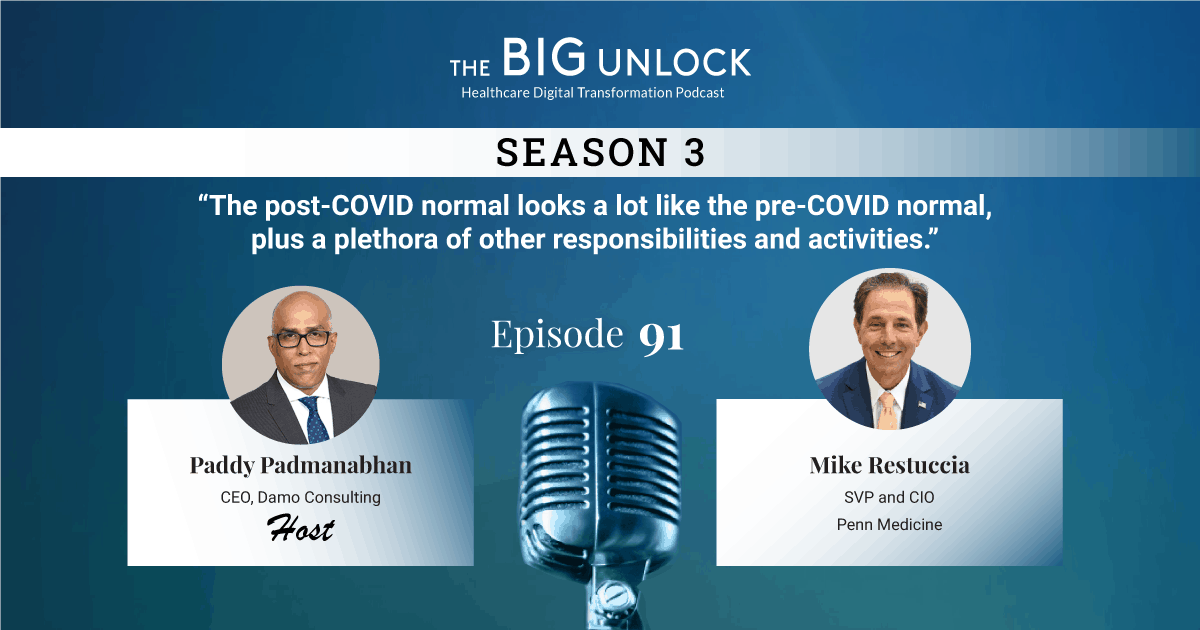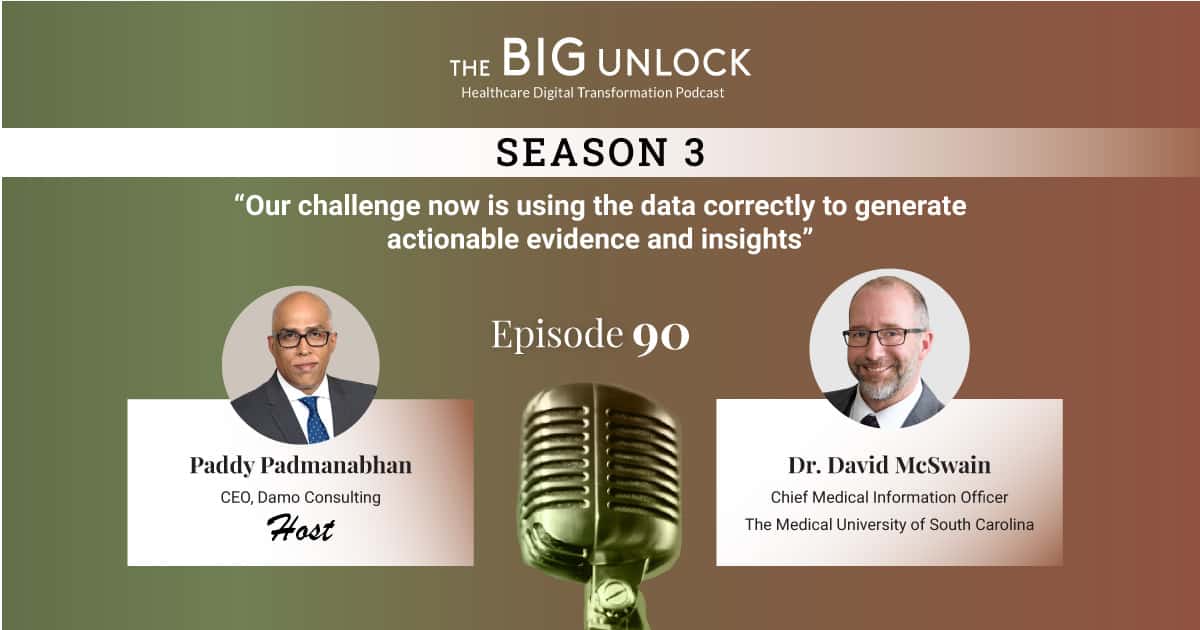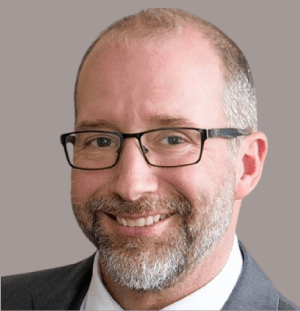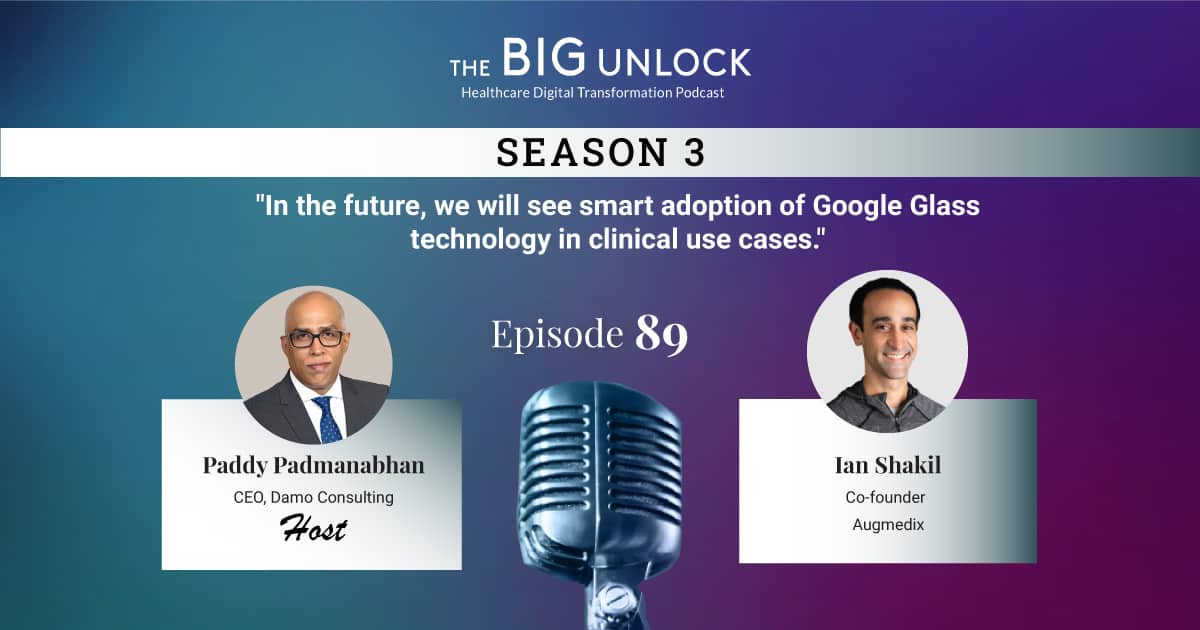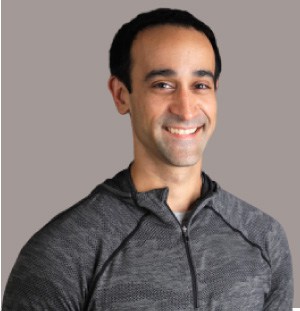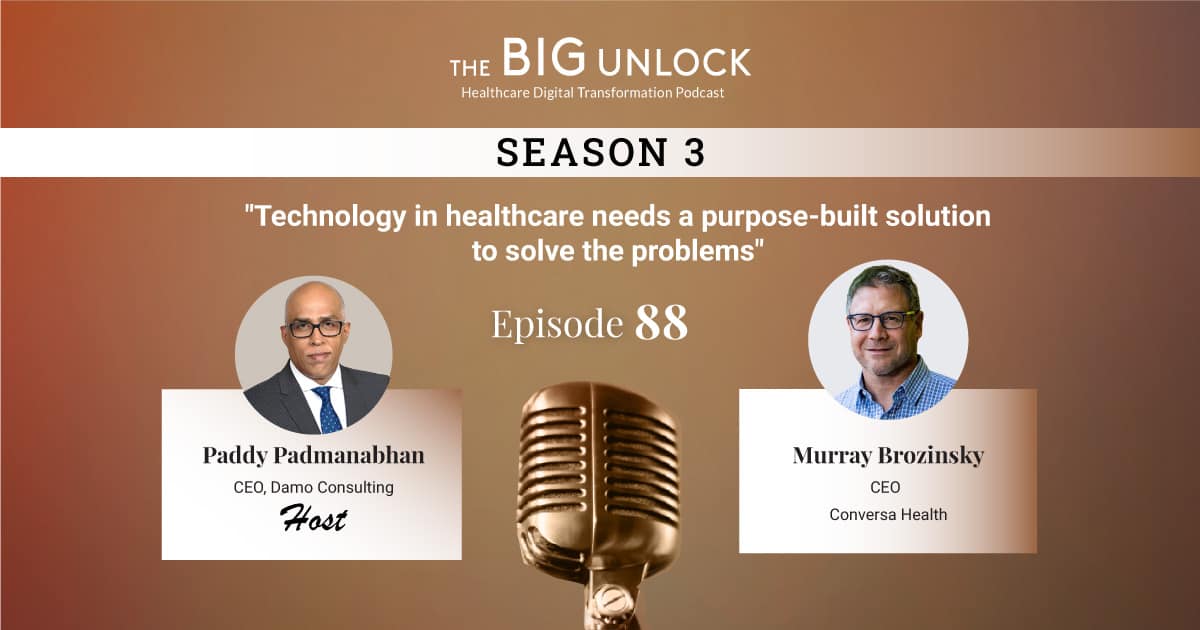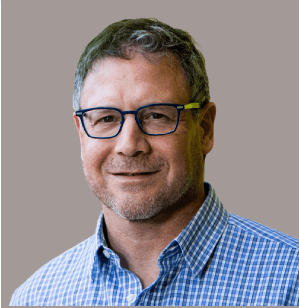Season 3: Episode #91
Podcast with Mike Restuccia, SVP and CIO, Penn Medicine
"The post-COVID normal looks a lot like the pre-COVID normal, plus a plethora of other responsibilities and activities."
 Hosted by Paddy Padmanabhan
Hosted by Paddy Padmanabhan 
Share
In this episode, Mike Restuccia discusses the state of telehealth in the pre-and post-COVID era and how the overall workload for the technology function has expanded significantly with the onset of virtual care models. He discussed the role of the IT function in the context of the overall mission of Penn Medicine that covers education, research and care delivery.
In this extended interview, Mike discusses a broad range of topics including the role of big tech and EHR companies in the digital transformation journey, his approach to technology vendor relationships, and a governance model for identifying and nurturing innovative startups. He discusses the use of newer data sources such as genomic data in the analytics programs at Penn and the challenges of AI-enabled solutions from the vendor community that overpromise and under-deliver.
Mike also shares how he spends a significant amount of time attracting and nurturing tech talent, and how to support and empower high-performing teams. Take a listen.
Note: Penn Medicine has published several insightful reports on the IT function’s contributions to the overall mission. These provide valuable insights into the functioning of one of the largest and most prestigious medical institutions in the country. Interested readers can download the reports here.
Show Notes |
||||
| 00:48 | What does the post-COVID normal look like at Penn Medicine? What you are working on to prepare for the next phase? | |||
| 02:52 | What are the broad trends in the healthcare sector and the changes in the competitive landscape that you are following at the enterprise level to drive technology priorities? | |||
| 07:41 | How have your patients, consumers, and caregiver community responded to the shift towards a digital mode of engagement? programs? | |||
| 10:33 | Have you reached an equilibrium between telehealth and in-person visits? Are you designing the future based on this equilibrium? | |||
| 12:44 | How do you leverage the technology partner ecosystem to drive your enterprise priorities? | |||
| 15:19 | When you realize that your existing partnerships might not have what you need, how do you go about sourcing it from elsewhere or you build it internally? Can you talk about your approach? | |||
| 18:09 | What's your advice for digital health startup founders who want to be a part of your journey and may have something? | |||
| 22:28 | What are the challenges that you have had to overcome, especially when harnessing innovation from the marketplace as opposed to innovation from within your existing technology partnerships? | |||
| 24:21 | Tell us a little bit about what is the overall mission when it comes to your data and analytics group. How are you supporting - the academic, the research and the health care delivery side of it? | |||
| 41:10 | Can you share best practices for the benefit of our industry colleagues on their digital journeys at various stages? | |||
Q: What does your post-COVID, new normal look like at Penn Medicine? What are you preparing for in the next phase, especially from a technology standpoint?
Michael: In many ways, the post-COVID normal looks like a lot like the pre-COVID normal plus a plethora of other responsibilities and activities. So, the post-COVID normal’s more frenetic with things that we’ll see much more of. Pre-COVID we’d been focused on expansion, running, maintaining and growing and all the EHR-type things. Post-COVID, it’s all that plus more engagement, faster expansion, greater monitoring of patients in our remote manor — all big lifts from an IS perspective. We had a pretty substantive role and job as a team pre-pandemic, and post it, it just doubles or triples and there’s no sign that it’s going to slow down.
Q: Interesting observation. Post-COVID, telehealth modalities and virtual care models have gained a lot of ground. What are the top three trends and how do those trends drive your technology priorities?
Michael: I will start with telehealth. Pre-pandemic, we were doing a few hundred tele-visits a month. At its peak, mid-pandemic, over 8000 tele-visits, a day. Now, it’s plateaued to around 3,000 per day, but that’s still significantly higher than our pre-pandemic days. Telehealth is here to stay. It’s an area we need to focus on and from a maturity perspective, we have a pretty good solution in place. But there are other vendors rapidly advancing their telemedicine delivery capabilities into us. Integration with our EHR is critical and getting that done in future will be top priority. Our patients and providers love it.
I had mentioned remote monitoring, a while ago, in the home or in particular within our ICUs across our six-hospitals’ enterprise. We have almost 250 ICU beds, and each is now monitored with a camera connected to a central location. Thus, tele ICU caters to 24*7 monitoring and care. It helps from the delivery of care and responsiveness perspectives and the staffing angle too, because those six hospitals are located in a 150-mile radius which makes staffing, mission-critical.
The third thing I’d speak to is just enhanced patient engagement, which can occur through the patient portal to deliver results, schedule appointments, undertake administrative types of tasks, pay bills, communicate with clinical teams or even, push information and alerts to our patients. That was significant through the pandemic. It was a new opportunity when outpatient clinics were re-opened after having ambulatory clinics, and then again significant with the re-opening of hospitals for non-essential surgeries.
We began an interactive texting campaign that communicated with patients via their phones and asked them a series of YES/NO questions 24-48 hours before they visited us. Based on the responses, the patient would either be cleared, or the employer would be cleared to come back to work. Patients could be cleared to come to the clinic or would be triaged off to a care team. The latter only if patients responded with a list of symptoms, we would not want them coming into the clinic. The care team would reach out to them at that point in time. This is another example of using technology for good engagements with patients.
Q: How have your patients and consumers responded to the shift towards digital modes of engagement? How has the caregiver community responded and what has that experience been like?
Michael: I’ll start with the patients first and this is a bit more anecdotal than scientific. What we consistently heard from the majority of the patients — and there is some differentiation based upon perhaps age or tech-savviness, irrespective — they were thankful. Thankful that we were attentive, concerned for their health and that of their caregivers and other patients in the general vicinity. Overall, it was a big win because of the positive engagement and the way we communicated with our patients.
From the caregivers’ perspectives, it was a big change in the workflow. Now one had to follow multiple steps just to see a patient. So overall, I think the response was mixed or much more positive than negative because interestingly, there was a segmentation of those physicians that were very comfortable using the technology and embraced the concept of using a telemedicine-type approach. This way, they could see more patients, have less downtime, maintain a higher adherence rate to the meeting, resulting in fewer no-shows. On the other hand, there were those that said a tele-visit was OK occasionally, but that patient had to be seen. This meant observing more than just how they were interacting through the screen.
Q: Your telehealth visits went up to about 8,000 a day from a few hundred a month. And then, fell to 3,000 a day today. Is this an equilibrium you have achieved? Are you designing the future based on this?
Michael: I think we’ve reached an equilibrium for now but there is substantial pent-up demand to come back and see in-person, which sort of impacts the decline and that plateauing. I feel there will be another bump in our use of telehealth for several reasons. One is we will have experienced that pent-up demand for in-person visits. Secondly, we’ve learned that not every visit has to be in-person and some balance/ratio of visits per patient can be maintained (one inpatient may have one in-person and two virtual visits, for example or that could be in ratio of 1:3). Thirdly, I think the strength of Penn Medicine lies in the breadth and diversity of care offered and as that expands, it will support more of the telehealth type of engagements.
Q: Penn Medicine, with its historical heritage and as an academic and research institute plus a healthcare delivery organization, is unique as is your mission. From a technology standpoint and your strategic tech partnerships, how does all this drive your mission?
Michael: We believe in few but deep partnerships. We don’t have five different vendors providing 12 different solutions for the same cause because we prefer going with one vendor across the board and implementing common systems that are centrally managed and collaboratively installed. That works very well, across the networking, EHR, telephony sides and other aspects. That’s our approach — standards and systems across the enterprise. We are focused on patient care research and teaching around 121 academic medical centers in the country. It is a unique mission that requires significant integration among those three towers than ever. Our approach towards genomics and leading that into patient care and precision medicine and precision health really makes these times exciting. And that where it gets real exciting with the things that we are doing that is transforming care. But from a partnership perspective, several solutions at most deep relationships that are common across the system is really the attributes that we seek.
Q: While your partners possibly deliver much of what you need, they don’t deliver everything. How do you go about sourcing this from elsewhere or building it internally? What is your approach like in this case?
Michael: Regardless of whether our partners are providing us the proper solution or not, we’re always looking to innovate and that’s within the corporate IS, as well as in partnership with our Center for Health Care Innovation, which is a close ally and very dependent upon corporate assets. So, the Center for Health Care Innovation is a part of Penn Medicine, led by Dr. David Asch and Roy Rosen and their team is focused on what we should be doing next to either improve efficiency, care, accelerate research. They’re quite focused on new technologies, workflows and endeavors and very dependent upon corporate IS for those networks, data, and project leadership in order to advance some of those causes.
How this works is — the Center for Health Care Innovation will identify an opportunity and organize the appropriate constituents because there’s more than IS and big thinkers that need to be in the room. One needs operational assistance, clinical assistance, perhaps research assistance as well. Once that’s organized, a proof of concept is performed to see if the thought really does hold water. If it does, then we try to do a pilot and one that’s completed, we try to determine whether corporate IS should try to scale it across the enterprise. That’s the kind of the approach we’ve taken internally to advance our causes. Often, whether it’s improving access to a particular department, making care more convenient for patients or introducing mechanisms so patients don’t have to come on-site as much and be treated more in the home, are examples of how the Center for Innovation has advanced certain causes.
Q: For digital health startup founders listening-in, how can they reach out to you or someone like you to showcase their solution or capability? Any advice to those who want to be a part of this and may have something?
Michael: People find ways to get to me, Roy Rosen, and Dr. Ashe — no challenge there. We’re pretty public figures. So, we encourage them to reach out and share their ideas and their thoughts. And we look at them all. Whether it’s patient care and engagement or access to care, all of these are things we’re readily looking at on a daily basis to try and improve upon. We’ve made a lot of advances because of the pandemic and there’s more to come. This spirit of being able to introduce things that were once thought to be not possible is amazing — Who would’ve thought you could go from 300 to 8,000 tele-visits? But when you focus on it, you can get it done.
We do have many people that reach out to us and find their way into the Penn Medicine ecosystem. It might be through a friend working here or a Board Member or via some other channel, and it just arrives. The first few times, we took a stab at trying to figure this out on the basis of the recommendations but realized that just because a person says they’re good doesn’t mean they necessarily are. We spent a lot of cycles trying to understand the firm’s stability, their product and their ability to need support, secure any data that we might share with them, their potential for long-term sustainability and had our misses.
So, we introduced a multidisciplinary committee that I Co-chair with Roy Rosen from the Center of Innovation Health Care Innovation, and we call it the New Technology Review. And before we go too far with any new potential partner, we ask them to present to the committee in a one-on-one to better understand their capabilities. This has dramatically lowered our misses, improved efficiency, communication, and efficacy as we move forward with some of these newer technologies and firms. We’ve managed to smooth the waters here and keep people focused on what’s most important.
Q: When you get new solutions, they should be compatible with your overall technology environment which can be quite a challenge. What are the top challenges you’ve overcome when harnessing innovation from the marketplace versus innovation from within your existing technology partnerships?
Michael: It’s the overselling, overpromising and then, under-delivering though some of the firms have been really solid. The sales teams or business development teams have a great vision, but on the flip side, they don’t really have the delivery mechanism tied to it. So, you end up short and that’s where my team ends up having to cover and pick up the slack, because by then, the idea has been sold and budgeted. Leaderships expects some results, after all. That to me is one of the biggest problems we’ve experienced.
Q: You’ve made great strides with your data analytics program and how you’re harnessing genomic. What is the overall mission for your data and analytics group? How are you supporting — the academic, the research and the healthcare delivery sides? What are some of the big successes or learnings you’ve had?
Michael: I’m not the greatest one with vision, but my team is using that construct of a common system — centrally managed and collaboratively installed. If you keep that as the overriding umbrella, then, the spirit around analytics was that we needed a centralized location where we could house patient care data, research data — biobanking, bio tissue, genomic data, and any other types of demographic data. That’s Penn GNP (Penn Genomics and Phenotype). That data is initially loaded in a raw format, so, if someone wants to reach in and grab raw data, they can if they’re savvy enough to do that.
We then move up a tier and we synthesize that raw data and homogenize it into common data definitions – a common data model accessible with common tools and probably a little easier then, for an end-user to reach in and grab what they want at some point. But again, it’s a common location that we’re zeroed-in on.
Finally, what we will do is move that data off into data mart so we might have patient safety and a quality mart. We might have a clinical care art. We might have a research mark that has just that specific domain data associated with it. We do all this now through the Azure Cloud, which we found again makes access to the data even easier through the utilization of standard tools that are accessible to all.
Our goal is to have our end users be less reliant on our data access team and more reliant on themselves through self-service. That may be a big lift for us as it is for many other organizations. How we communicate and educate that end user community and liberate the data for their use so that they’re not as dependent upon us is critical.
Some of the big successes for us are — we were one of the first, if not the first, to begin to take discrete genomic lab results from one of our lab partners and integrate that into our EHR. We put a whole program in place on how to make that work, utilizing our genomics team, genomics counselors, members of our cancer center and then, certainly our end user clinical staff community. We ensured that when these Genomic results showed up in a patient’s chart, the latter was aware of what they had, their result and the implications to the caregiver because many of them could require some level of training and education on how to discern what that variant result might be.
Q: AI means a lot of things to a lot of people. How have you been able to leverage AI, ML, Analytics tools in the context of your data and analytics programs?
Michael: AI falls right under that banner of over-promising and under-delivering and I don’t think I’m the only one to say that. You’re more connected in the industry than I am, Paddy, but I have hope for it because much like innovation was a four-letter word a bunch of years ago, AI is becoming a four letter word since it’s just overpromised at this point with limited, tangible results.
That doesn’t mean that we’re not making strides towards it being more and more beneficial. We are taking a two-pronged approach towards AI. The first is a top-down approach, where we will work with members of the vendor community who claim to have this algorithm whereby if you give it the right data in the right format at the right time and in the right sequence, it’ll tell you something. It might tell you whether — you’re going to have a higher no-show rate, there’s going to be a health deterioration, Sepsis is on the horizon etc. And that’s our top-down approach, where globally we’ll just lay it over the enterprise. We’ve had minimal success with that so far.
We also have a bottom-up approach. I have a team of seven or eight data scientists that work in a more discreet manner with our end user community and some passionate clinicians or researchers who claim they have this great idea. And if only they’ve observed certain things or had data on those things, it could be combined again. In some way, we could develop an in-house algorithm that would bring great benefit to the group. And I think we’ve seen that particularly in at-home care. We see that in palliative care, where we’ve predicted certain occurrences, but that’s in a very narrow tower. It’s not as broad as my top-down approach. So, we will continue on both streams because we think there’s hope. We are big believers, that the answers are in the data or are often in the data and we just have to get better at figuring out how to combine that data in order to generate a proper result.
Q: That’s a very well-balanced articulation of the promise, the potential and the actual performance of AI, today. And like you, I’m optimistic about the future as well. I know you spend a lot of time on your people. How do you ensure that you’re attracting, retaining and nurturing talent within the organization? All this technology is only as good as the people who are committed to making it all work.
Michael: When I joined Penn Medicine 14 years ago, 95% of our IS services were outsourced to third-party vendors. That was done 20 plus years ago for a variety of reasons — cost containment, standardization of delivery capabilities etc. What I was asked to do was help build a team that would in-source the majority of those services, because if you’re going to have world-class clinicians, researchers and educators, you better have world class IS.
In order to enable it — and you’re generally not going to get that passion and commitment from a third party — my job was to rebuild the team, internally. That took about three or four years to in-source, and during that time it gave me and my team, the opportunity to build a culture that was accountable, exceeded expectations, and in which we were viewed as consultative and partners versus just “those folks in IS.”
Building that culture has really put us in a position where we’re attractive to those that we recruit. We want 100% of the people to be doing 200% of the work and be accountable. Our mantra outside of corporate IS is, we always deliver. And it’s not easy to do that and so people do go above and beyond and exceed those expectations. That was a culture we strove to build.
I’ve had the good fortune of working places prior in my career where I saw that culture. I thrived there and wanted to replicate that. Now, we are a USD 280 Mn IS operations business, here. And a big business cannot function properly without really good people. My teammates are great, our leadership’s exceptional.
One of the things that caught me — and I probably haven’t shared this with you before or my team — is despite the fact where you are in Penn Medicine, part of University of Penn trustees, we really didn’t have an internal Managerial Training Program. And if you look at statistics and surveys, one of the top reasons why people come to work every day for that employer is they like working for their manager, they respect their manager, they believe their manager has their best intentions for them with their career and their personal work-life balance.
Well, Penn Medicine has subsequently introduced the Managerial Training Program, but IS did this first, and on our own. We formed a program, educated our managers on how to be not only good technically, but good personally, in their management styles. That to me was one of the best things we’ve done within our organization.
I have over 100 managers and often in a technology world the people that become managers are the best subject matter experts in their technology. Well, I think we all know just because you’re a really good C++ programmer or a really good infrastructure networking person doesn’t mean you’re a good people manager. And we had to bridge that gap and we’ve done that through a series of internal trainings, hosting webinars, team meetings, book readings, book discussions and team discussions, and it’s really elevated our ability to manage. Each of my team has now been through 360 events, twice. So, they’re receiving feedback from all around them — their employees, leaders, colleagues etc. If you invest in people, they’ll respect you, like the culture and in the end, this will account for a really low turnover and really high retention rates.
Q: You also published a biannual and having read the document, I’ve found it to be very informative. For those who are listening to this podcast and watching this, I strongly encourage downloading the documents and learning a little bit about what and how medicine does it.
Michael: I’m happy to share that link with you. Our Benefits Realization is one document that states the financial impact corporate IS has on many of the larger projects. And we do that every two years. In between those two years, we do the State of the Union, which highlights the big projects that we were working on, a little less on benefits, but more on the function of that particular project. And we do that because marketing our services is important so the external community understands our end users, what we’re working on, where that USD 280 million is going to. It’s also really rewarding and refreshing to the employees to see their efforts in print and recognize that. “I worked on that with that department or that center or that entity,” has a ring of a sense of pride, a sense of ownership and a lot of what Penn Medicine is about, is that pride and ownership.
Q: I’d like to conclude this session with one or two best practices or learnings and especially in the context of this transformation that the industry is going through. What would you like our listeners to take away from your experience?
Michael: First, we have to recognize the unique situation we are all in — any individual can make a big impact in some way, shape or form. Within industry or within personal and social lives, anyone can make a big difference. I happen to sit in the seat of the C.I.O. so, I have a bit more influence than most. What I have found is, you need to be bold, selective and pick your shots and go hard at them.
When I joined, one of the goals was to in-source the services, but that wasn’t so bold. It was more something that I needed to do type of thing. I thought some of the boldness way back then was saying we needed to get to an integrated health milestone.
Back then, everybody had their own little pet product or pet solution for filling in. Each ambulatory department had their own car — Orthopaedics or GI — and nothing was connected. The boldness was to get to one and being able to fight off all the reasons that people would give you for not getting to one and continually representing what the benefits could be. Once the approvals were got, then still having energy left and implementing that type of a solution today may not seem like a bold premise. But back then, it certainly was. And it makes a big difference today.
I think when I look at what is there and what’s going to be more of, I come up with more genomics, more data, more engagement – the whole precision medicine. The approach we’re focused on has led us to restructure the corporate team, so we’re focused on maintaining power and doing things on the research side. Now, we have a team focused on bringing those two together, and that’s bold and unique. But as mentioned, Penn Medicine is a pretty unique place.
So, we need to take this to the next level and leverage that position without forgetting all day-to-day activities that have to still take place.
About our guest
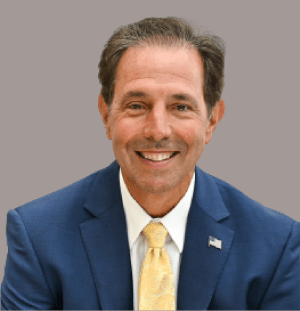
Michael Restuccia is the Senior Vice President and Chief Information Officer (CIO) at Penn Medicine. Restuccia has over thirty years of healthcare information technology experience and has worked nearly all his career in the healthcare information technology provider, vendor and consulting services industries.
Prior to joining Penn Medicine as an IS management consultant in 2006, Mr. Restuccia served as President of MedMatica Consulting Associates, a healthcare information technology consulting firm that has been recognized as a four-time recipient of the Inc. Magazine 5,000 Fastest Growing, Privately Held Companies in the US and the Philadelphia region.
While at MedMatica, Restuccia served as the Interim Chief Information Officer for several healthcare organizations, including Phoenixville Hospital, Doylestown Hospital and the University of Pennsylvania Health System. Prior to MedMatica, Restuccia served in leadership roles with several other healthcare information technology firms, including First Consulting Group and Shared Medical Systems (now Cerner Corp.). Restuccia achieved a Bachelor of Science degree from Rider University and earned a MBA from Villanova University.
Recent Episodes
About the host
Paddy is the co-author of Healthcare Digital Transformation – How Consumerism, Technology and Pandemic are Accelerating the Future (Taylor & Francis, Aug 2020), along with Edward W. Marx. Paddy is also the author of the best-selling book The Big Unlock – Harnessing Data and Growing Digital Health Businesses in a Value-based Care Era (Archway Publishing, 2017). He is the host of the highly subscribed The Big Unlock podcast on digital transformation in healthcare featuring C-level executives from the healthcare and technology sectors. He is widely published and has a by-lined column in CIO Magazine and other respected industry publications.

